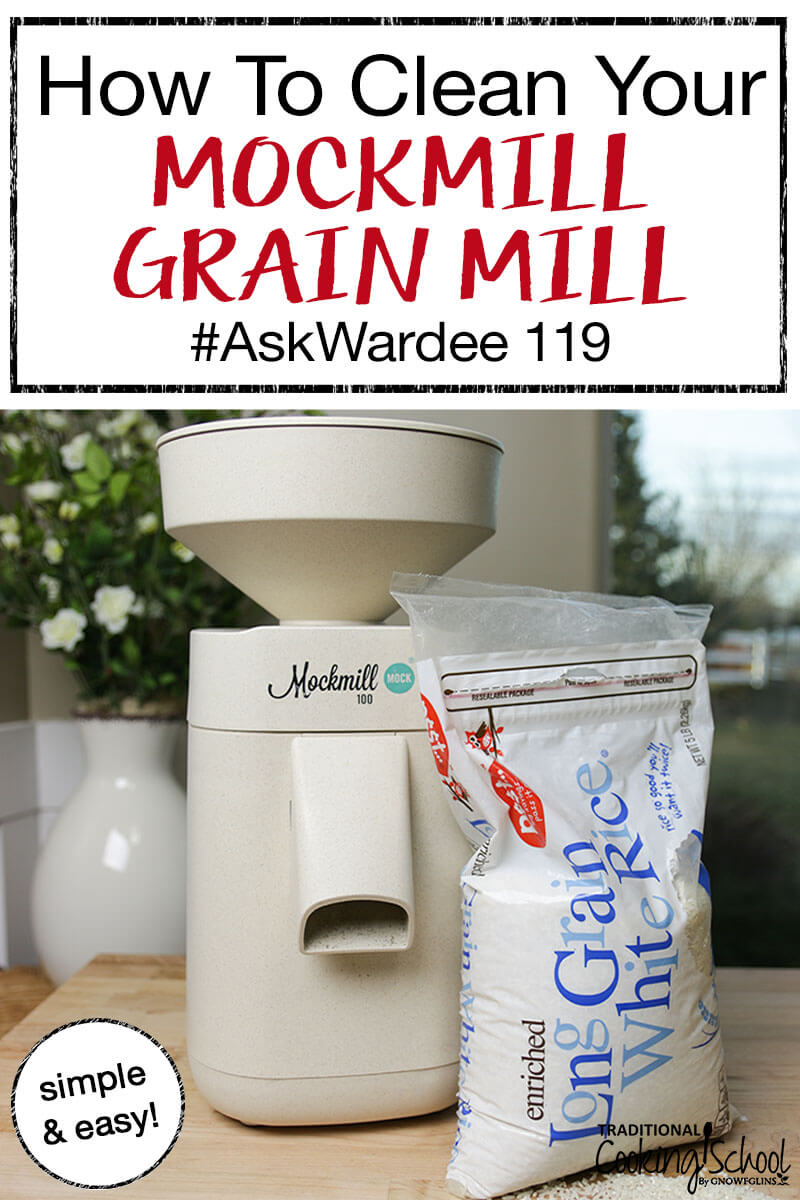
Want our FREE “Home Grain Milling 101” eBook? Click here to download the “Home Grain Milling 101” eBook for FREE!
So you just ground pepper or something very fragrant in your Mockmill, and you DON’T want that to get in your flour for baking.
How do you clean the mill, though?
Well, it’s easy! And simple!
On today’s #AskWardee, I’m showing you how to clean your Mockmill in between uses. And even how to do a deeper cleaning if necessary!
Subscribe to #AskWardee on iTunes, Stitcher, YouTube, or the Podcasts app.
The Question: How To Clean The Mockmill Between Different Flours?
Jeanette V. asked:
I just ground pepper in my Mockmill and I want to grind einkorn now. The trouble is, the mill is still spitting out bits of pepper… which I do NOT want in my flour. How do you clean your Mockmill between different flours/spices? And also, how can I be sure it’s really clean if I can’t see inside?
Thanks for this question, Jeanette. 🙂

Clean Your Mockmill With White Rice!
When you’re switching grinding something fragrant (like pepper or other spices) to a baking flour where you do not want that fragrance in there…
…just run some cheap white rice through the mill!
And by cheap, I mean cheap. I’m talking not organic, or anything special.
My bag came from Kroger and it cost a little over $1, if I remember right!
Because it’s going to be thrown out, so no sense spending a fortune on it, right? 🙂
BUT… if you don’t like that at all and want to use your good white or brown rice, then use it, then keep it and cook it up! A little pepper or fennel in a rice porridge is delicious!
Here’s How To Clean The Mockmill In Between Uses… Using Rice!
- Put a bowl in front of the Mockmill spout.
- Adjust the setting lever to position 10 (coarsest).
- Turn the mill on.
- Add 1/2 to 1 cup of white rice to the hopper.
- While it’s milling, adjust from coarse to fine and back to coarse. This cleans the stones as it grinds!
- Keep running the rice through until what comes out of the Mockmill no longer has spice residue in it.
- Discard or compost the ground rice.
If you use good rice instead of cheap rice, then keep it and cook it up for a fragrant rice porridge!
What If The Stones Are Glazed, Though?
The stones do get “glazed” sometimes.
This means they are coated with what they’ve been grinding and there is no longer friction between them to grind food effectively.
Usually this is because something oily or wet was put through the mill. This creates a paste that coats the stones, which halts their grinding ability.
Or maybe the Mockmill has been used a lot and has residue inside that needs cleaning.
Please note: be sure you review your manual for what can be ground and what cannot be ground. Generally, all grains, beans, and seeds that are dry and non-oily are fine. If you venture into coconut, chia seed, or foods like that, your stones may become glazed!
White rice takes care of most of this, as well! However, it’s very important to clean the mill immediately after you notice glazing. It’s a lot easier to clean while the “paste” is fresh.
All you have to do, most of the time, is to run white rice through on coarse, then more through a little finer, and so on. Repeat several times, setting it finer each time, and this usually takes care of it.
How To De-Glaze The Stones If White Rice Doesn’t Work
If that still doesn’t work, you can push the stones farther apart by creating a setting of 30 (with the stones very far apart… more coarse).
But the mill only goes up to 10, right? Yes, but we can adjust it more coarse this way:
- Move the setting lever to 10.
- Unscrew the lever a bit (to loosen it).
- Move the lever to 1.
- Tighten the lever.
- Now push the lever to 10, which is now actually 20 (coarser) due to the adjustment.
- Unscrew the lever a bit (to loosen it again).
- Move the lever back to 1.
- Tighten the lever.
- Finally, push the lever to 10, which is now actually 30 due our second adjustment.
Now run 1 cup of white rice through on 30 (it says 10 but we know due to adjustment that it’s temporarily 30). It will be very coarse or whole.
Bring the lever down to 1 (which is actually 21 due to our adjustment) and run 1/2 cup of the same rice through. If it seems like it’s grinding, like the stones are getting cleaned and deglazed, then move on. If not, put the lever back to 10 (actually 30) and run the rice through again. Or run it through on 1 (actually 21) again.
When it’s making progress, readjust the setting lever back to the true 10 (by reversing steps 1 through 9 above… except loosening at 1 and tightening at 10). Run the 1 cup of rice through again and if it seems like it’s beginning to grind better, adjust from coarse to fine and back again while milling.
So, you see, this mill is very easy to clean!
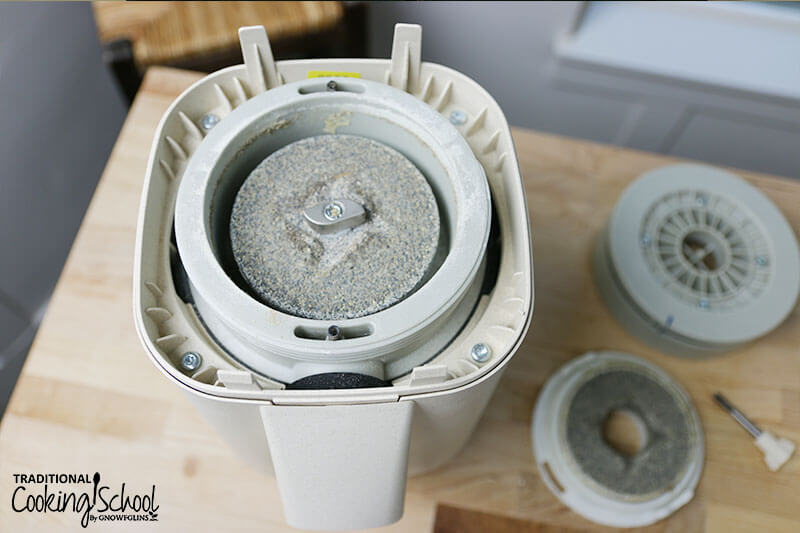
How To Manually Clean The Stones Or Inspect The Inside Of The Mockmill
You might want to get into your Mockmill to see if it’s clean in there. It can build up residue. Although cleaning with white rice above usually takes care of everything, maybe once in awhile you’ll have to clean the stones manually.
Don’t be scared by this — it’s actually quite easy! If you removed the transport locking clips when you got the mill, you’ve already practically done it!
- Unplug the Mockmill.
- Unscrew the setting lever (that adjusts fineness/coarseness).
- Press the tabs at the back of the hopper to lift it off the Mockmill.
- Unscrew grey cap of grinding chamber.
- Remove the top stone off by lifting the white cap attached to it. Be careful not to disturb the two springs that are in the casing around the bottom stones (see photo above).
- Inspect and/or clean the stones and grinding chamber with soft items (nothing that can damage the stones) such as your fingers, cloth, brush, chopstick, popsicle stick, etc.
- Put the top stone back on.
- Screw the grey cap back on until the black mark is at 5 o’clock-ish, then turn it back to 3 o’clock.
- Put the movable inner segment (what the setting lever screws into) to 3 o’clock as well.
- Pop the top of the mill back on.
- Finally, screw in the setting lever (into the movable inner segment).
This quick video shows you my daughter Haniya unboxing her Mockmill and removing the transport locking clips. It’s all nearly the same as the steps above, with the exception of revealing and cleaning the stones. It will show you how easy it is to disassemble and reassemble the Mockmill!
More Info From Mockmill
Here’s a video of Paul from Mockmill showing how he cleans and inspects the mill. The speed and comfort with which he opens, disassembles, and reassembles it is really impressive! I think you’ll learn a lot from it. 🙂
And here is Mockmill’s official Help Docs/Troubleshooting information.
Any Questions?
That’s it! So simple to clean the Mockmill in between uses or just to clean it up after a lot of use!
If you have other questions, be sure to leave them in the comments!
My Favorite Grain Mill: The Mockmill
As you can tell from this series, the Mockmill is my favorite grain mill and the one I recommend! I’ve been recommending it for a year and lots of you have already gotten one in your homes. Mockmill tells me you’re very happy and I’m glad about that. 🙂
The Mockmill is a home stone grain mill, and it’s engineered and manufactured in Germany by Wolfgang Mock. He started making home grain mills back in the 1970s, so he’s been doing it for over 40 years. It’s estimated that nearly 70% of the stone mills out there are made by him.
This mill is super exciting because it contains the best features of Wolfgang Mock’s milling career, yet it’s much more affordable. The reason it’s more affordable is because this mill comes in a durable recycled material housing (instead of expensive wood).
I love the Mockmill because it produces super healthy freshly-ground flour with a really fine texture. It doesn’t warm the flour up like some mills do, so the flour is more nutritious. Finally, the flour yields wonderful, light bread!
This mill will also grind all grains, even gluten-free. It can even crack grains for porridge, and it has many other uses (like some spices, nuts, and seeds). This Whole Grain Primer talks about each grain in particular, its uses and nutrition, to help you incorporate them into your diet.
See How The Mockmill Works In This Video…
All the details — including the very affordable price and FREE SHIPPING — are on this page. By the way, it also comes as a KitchenAid attachment — very exciting for those who don’t want another appliance to take up any more room!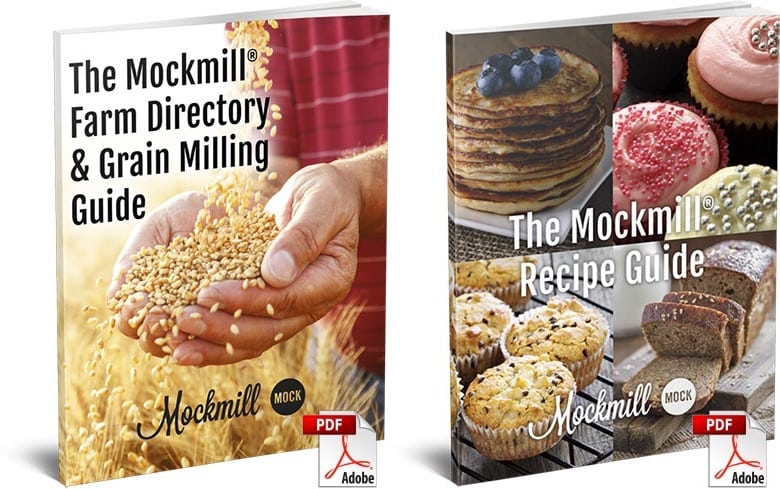 Also with your purchase of the Mockmill, you’ll get two fantastic eBooks from the Mockmill team: The Mockmill Farm Directory & Grain Milling Guide and The Mockmill Recipe Guide. Both of these eBooks are fabulous!
Also with your purchase of the Mockmill, you’ll get two fantastic eBooks from the Mockmill team: The Mockmill Farm Directory & Grain Milling Guide and The Mockmill Recipe Guide. Both of these eBooks are fabulous!
And, for a limited time… if you decide to purchase the Mockmill, I’m ALSO throwing in complimentary copies of both my Sourdough A to Z and Einkorn Baking eBook and Video Packages. They’re each worth $64 for a total of $128 in additional bonuses from me.
To claim your extra free bonuses from me after purchasing the Mockmill, just go to tradcookschool.com/millbonus. Have your order # handy, because you’ll need it to claim the two free eBook packages! (Your bonuses from Mockmill will come from them.)
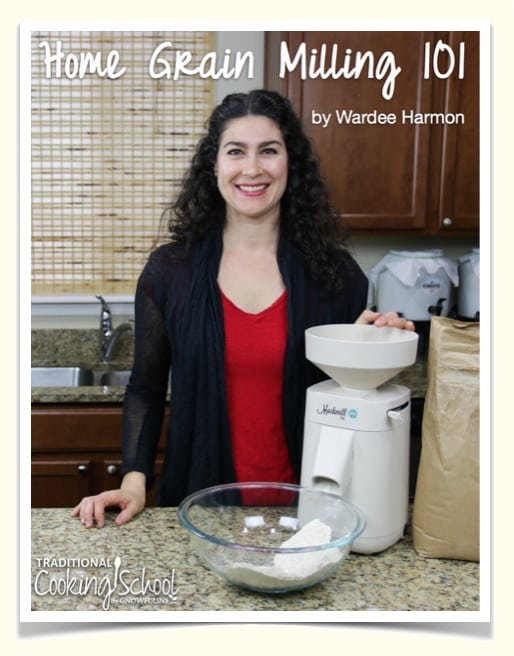 Want our FREE “Home Grain Milling 101” eBook? Click here to download the “Home Grain Milling 101” eBook for FREE!
Want our FREE “Home Grain Milling 101” eBook? Click here to download the “Home Grain Milling 101” eBook for FREE!
Helpful Links
- The Mockmill — my favorite and recommended (affordable) home stone grain mill — Hurry! The limited time offer to get my eBook packages valued at $128 won’t last long!
- Claim your FREE ($128 value) bonuses from me with your purchase of the Mockmill here!
- 8-cup hand-crank sifter
- Free “Home Grain Milling 101” eBook — our entire 4-part series combined into a single, FREE download from me!
- Home Grain Milling 101, Part 1: The Basics
- Home Grain Milling 101, Part 2: Milling Gluten-Free Grains Into Flour
- Home Grain Milling 101, Part 3: Baking With Fresh Ground Flour
- Home Grain Milling 101, Part 4: More Fun Things Your Grain Mill Can Do!
- Do Sprouting, Culturing, Or Sourdough Reduce Carbs? AW905
- FREE Webclass: Baking With Fresh-Ground Flour
- FREE No-Knead Sourdough Einkorn Bread Recipe
- FREE Sourdough Starter Instructions
- Why I <3 Einkorn — in case you want to know why we bake with the healthier 5,000 year-old wheat called einkorn!
- Where To Buy Einkorn
More Mockmill Related Articles from the #AskWardee Show:
- How To Sift Flour… aka Homemade “All-Purpose” Flour #AskWardee 117
- Differences Between Nutrimill And Mockmill #AskWardee 120
- Where To Buy Whole Wheat Berries, Grains, and Flour #AskWardee 148
- How to Store Flour and Grains#AskWardee 149
- How to Mill Flour at Home: Home Grain Milling 101
- Buckwheat Flour 101: Choosing, Milling Flour, Sprouting, Recipes & More! #AskWardee 141
- Milling Soft Wheat In A Grain Mill {Homemade Pastry Flour} #AskWardee 131
- Is The New Ultragrain White Whole Wheat Healthy? #AskWardee 112
How often do you clean your Mockmill? What method works for you?
We only recommend products and services we wholeheartedly endorse. This post may contain special links through which we earn a small commission if you make a purchase (though your price is the same).

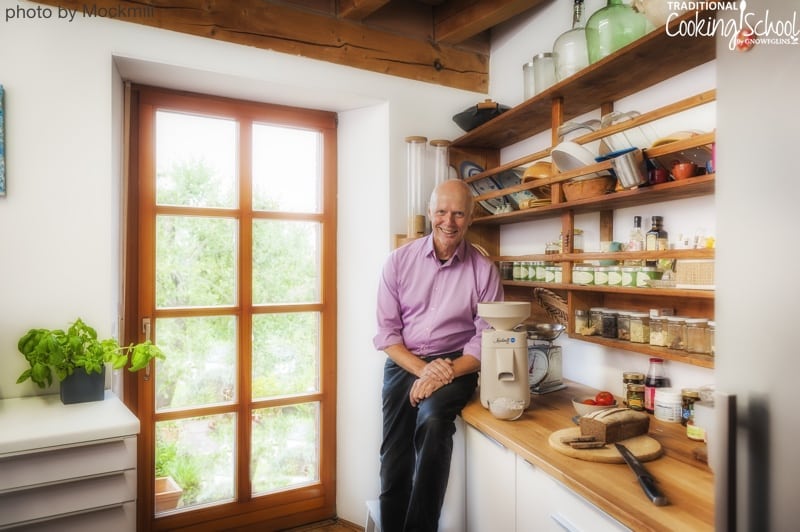


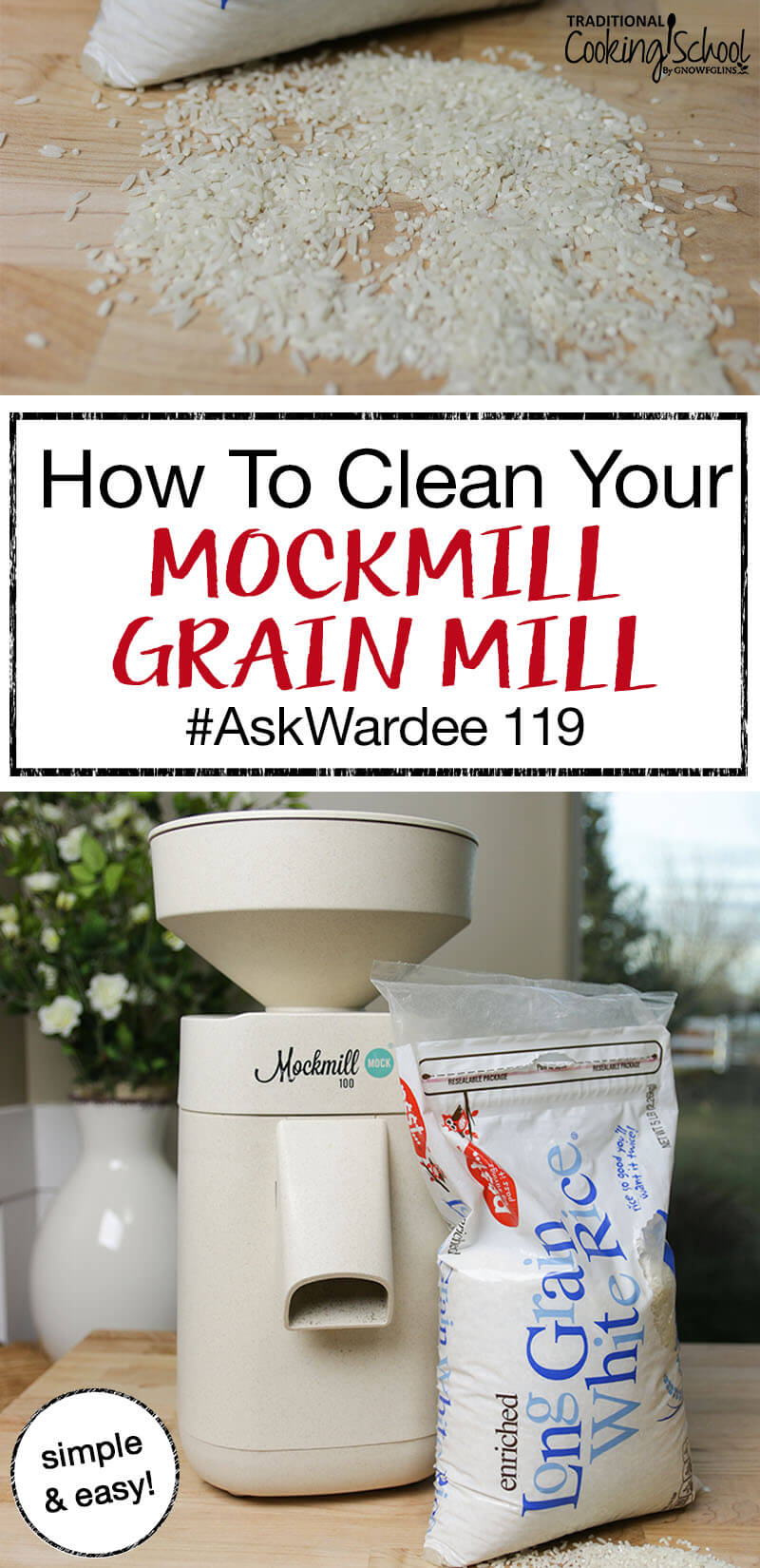
If your not using grain that they had back in the 1950 and later your killing your self slowly , the wheat that is grown
Today is another anamal and cause you nothing but greet.
I quit eating bread and flour cookies cakes all that stuff a few years ago never miss it ,the grain today is not fit for
Human consumption, it causes all kinds of health problems, nut old grain is being made by a small few , the
Wheat plant today is a third the height it was in the 1950
And puts out three to four times what the mother plants did. It’s been turned into a killing machine , I’m serious ,
Fred
Hi, Fred. Thank you for sharing.
We agree with a lot of this… and that’s why we recommend einkorn if one can afford. It’s the oldest variety of wheat and is much healthier than today’s wheat.